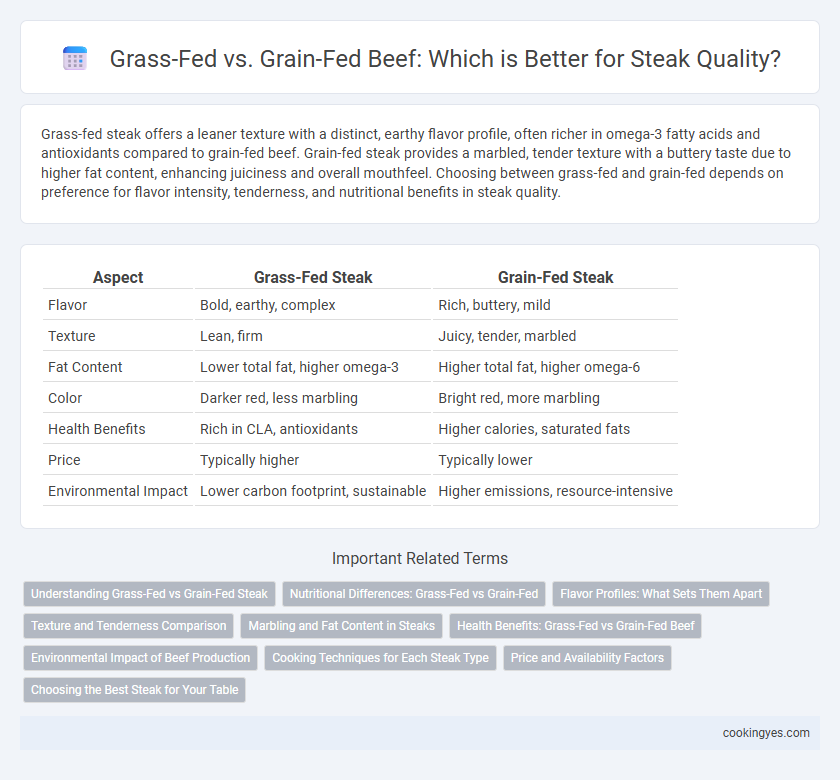Grass-fed steak offers a leaner texture with a distinct, earthy flavor profile, often richer in omega-3 fatty acids and antioxidants compared to grain-fed beef. Grain-fed steak provides a marbled, tender texture with a buttery taste due to higher fat content, enhancing juiciness and overall mouthfeel. Choosing between grass-fed and grain-fed depends on preference for flavor intensity, tenderness, and nutritional benefits in steak quality.
Table of Comparison
| Aspect | Grass-Fed Steak | Grain-Fed Steak |
|---|---|---|
| Flavor | Bold, earthy, complex | Rich, buttery, mild |
| Texture | Lean, firm | Juicy, tender, marbled |
| Fat Content | Lower total fat, higher omega-3 | Higher total fat, higher omega-6 |
| Color | Darker red, less marbling | Bright red, more marbling |
| Health Benefits | Rich in CLA, antioxidants | Higher calories, saturated fats |
| Price | Typically higher | Typically lower |
| Environmental Impact | Lower carbon footprint, sustainable | Higher emissions, resource-intensive |
Understanding Grass-Fed vs Grain-Fed Steak
Grass-fed steak comes from cattle that graze on natural pastures, resulting in leaner meat with higher levels of omega-3 fatty acids and antioxidants. Grain-fed steak is produced from cattle finished on grain-based diets, typically corn or barley, which enhances marbling and tenderness due to increased fat content. Understanding these differences helps consumers choose based on flavor preferences, nutritional benefits, and cooking methods suited to either grass-fed or grain-fed beef.
Nutritional Differences: Grass-Fed vs Grain-Fed
Grass-fed steak typically contains higher levels of omega-3 fatty acids, conjugated linoleic acid (CLA), and antioxidants such as vitamin E and beta-carotene, contributing to enhanced nutritional benefits. Grain-fed steak, on the other hand, generally has a higher fat content and more marbling, which affects flavor and tenderness but results in a higher calorie count. The distinct fatty acid profiles between grass-fed and grain-fed beef impact heart health, with grass-fed offering a leaner option and improved ratios of beneficial fats.
Flavor Profiles: What Sets Them Apart
Grass-fed steak offers a robust, earthy flavor with a leaner texture and distinct grassy undertones, appealing to those seeking a natural, complex taste. Grain-fed steak provides a richer, buttery flavor with more marbling, resulting in a tender, juicy bite favored for its balanced sweetness and mild aroma. The difference in feed impacts fat composition and muscle structure, directly influencing the steak's juiciness, tenderness, and overall flavor intensity.
Texture and Tenderness Comparison
Grass-fed steaks typically have a firmer texture and leaner profile due to higher muscle density and lower fat content, which can result in a slightly chewier bite. Grain-fed steaks generally offer superior tenderness and a more buttery mouthfeel, attributed to increased marbling and intramuscular fat. Preference for texture and tenderness often depends on individual taste, with grain-fed favored for softness and grass-fed valued for a more robust, fibrous chew.
Marbling and Fat Content in Steaks
Grass-fed steak typically features leaner meat with less marbling, resulting in a firmer texture and a more pronounced, earthy flavor profile. Grain-fed steak offers higher fat content and abundant marbling, contributing to a tender bite and richer, buttery taste. The increased intramuscular fat in grain-fed beef enhances juiciness and mouthfeel, making it a preferred choice for those seeking premium steak quality.
Health Benefits: Grass-Fed vs Grain-Fed Beef
Grass-fed beef contains higher levels of omega-3 fatty acids, antioxidants, and conjugated linoleic acid (CLA), which contribute to improved heart health and reduced inflammation. Grain-fed beef offers more marbling, enhancing tenderness and flavor but typically has a higher fat content with fewer omega-3s compared to grass-fed. Choosing grass-fed beef supports a leaner protein source with potentially greater nutritional benefits for cardiovascular health.
Environmental Impact of Beef Production
Grass-fed beef production generally has a lower environmental impact due to its reliance on natural grazing systems that promote soil health and reduce the need for synthetic inputs. Grain-fed beef typically requires intensive crop cultivation for feed, contributing to higher greenhouse gas emissions and greater water usage. Choosing grass-fed steak supports more sustainable agricultural practices with improved carbon sequestration and biodiversity conservation.
Cooking Techniques for Each Steak Type
Grass-fed steaks, known for their leaner texture and intense beef flavor, benefit from quick, high-heat cooking methods like grilling or pan-searing to preserve tenderness and develop a flavorful crust. Grain-fed steaks possess higher marbling and fat content, making them ideal for slower cooking techniques such as sous vide or reverse searing to enhance juiciness and rich buttery taste. Adjusting cooking approaches based on feeding style maximizes the steak's natural qualities and ensures optimal texture and flavor.
Price and Availability Factors
Grass-fed steaks typically command higher prices due to more expensive, slower-raising practices and limited seasonal availability, especially in regions with less pastureland. Grain-fed steaks are generally more affordable and widely accessible year-round, benefiting from intensive farming methods and predictable supply chains. Consumers seeking premium flavor profiles and organic labeling often accept the cost premium and occasional scarcity of grass-fed options.
Choosing the Best Steak for Your Table
Grass-fed steaks offer a leaner profile with higher levels of omega-3 fatty acids and antioxidants, providing a more robust, earthy flavor preferred by health-conscious consumers. Grain-fed steaks, known for their marbled fat, deliver a tender, buttery texture and richer taste favored by those seeking maximum juiciness and tenderness. Choosing the best steak depends on balancing nutritional benefits with desired flavor and texture, making grass-fed ideal for lean eating and grain-fed optimal for indulgent dining experiences.
Grass-fed vs Grain-fed for Steak Quality Infographic

 cookingyes.com
cookingyes.com